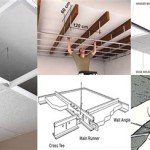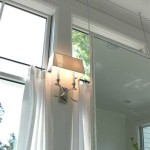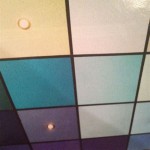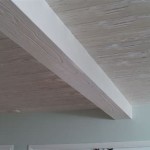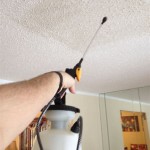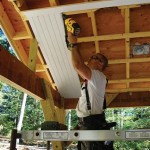What Material Is False Ceiling Made Of In Homes?
False ceilings, also known as drop ceilings, are an increasingly popular design choice for homes. They provide a myriad of benefits, including improved aesthetics, enhanced insulation, and the ability to conceal wiring and plumbing. Choosing the right material for your false ceiling is crucial, as it will heavily influence the overall appearance, functionality, and longevity of your home. This article delves into the diverse materials used to construct false ceilings, exploring their unique characteristics and suitability for different applications.
Gypsum Board
Gypsum board, commonly referred to as drywall, is a widely used material for false ceilings due to its affordability, versatility, and ease of installation. It consists of a gypsum core sandwiched between two layers of thick paper. Gypsum board is available in various sizes and thicknesses, allowing for customization based on specific design requirements. This material offers excellent fire resistance and sound absorption qualities. Gypsum board is also readily available, making it an economical choice for most homeowners.
However, gypsum board is susceptible to water damage and may require additional layers of paint or sealant to achieve a desired finish. Its weight can also be a concern for certain applications, requiring specialized support structures. Additionally, gypsum board is not a suitable material for environments prone to high humidity.
Plywood
Plywood is another popular choice for false ceilings, known for its strength, stability, and resistance to warping. It is composed of thin layers of wood veneer glued together with alternating grain directions, resulting in a durable and resilient material. Plywood offers excellent sound insulation properties and can be easily painted or stained to match existing décor. It is also a good choice for areas with high humidity, as it is less susceptible to water damage than gypsum board.
However, compared to gypsum board, plywood can be more challenging to install and may require specialized tools. It is also more expensive than gypsum board and may exhibit a less smooth finish, requiring additional sanding and priming before painting. Plywood can also be prone to scratches and dents if not properly handled.
Metal
Metal, primarily aluminum and steel, is often used for false ceilings in commercial settings but is increasingly gaining popularity in residential applications. These materials are lightweight, durable, and fire-resistant, making them ideal for high-traffic areas or spaces where fire safety is a concern. Metal false ceilings also offer excellent acoustic properties and are resistant to moisture, making them suitable for bathrooms and kitchens.
Metal ceilings come in various finishes, including painted, textured, and perforated designs. They are also available in a wide array of formats, from grid systems to modular panels, allowing for flexibility in customization. However, metal ceilings can be more expensive than other options, and they may require specialized contractors for installation. Metal can also conduct heat, making it less suitable for areas with high temperatures.
Wood
Wood, particularly reclaimed wood, offers a natural and rustic appeal for false ceilings. It can be incorporated in various ways, from tongue-and-groove planks to exposed beams. Wooden false ceilings create a warm and inviting ambiance and can be customized to suit different architectural styles. Wood also absorbs sound and provides excellent insulation, contributing to a more comfortable living environment.
However, wood can be more expensive than other materials and requires regular maintenance to prevent warping, cracking, or decay. It is also susceptible to moisture damage and may require additional treatments to ensure its longevity. Additionally, wooden false ceilings may require specialized construction techniques, potentially increasing installation costs.
Fabric
Fabric is an unusual but increasingly popular material for false ceilings, particularly in contemporary homes. It offers a soft, elegant, and acoustically effective solution. Fabric ceilings can be used to create a variety of textures and patterns, adding a unique touch to any room. They also provide excellent sound absorption, making them ideal for home theaters or other spaces where noise reduction is crucial.
However, fabric ceilings require careful planning and installation. They are susceptible to stains and require regular cleaning to maintain their appearance. Fabric ceilings are also not suitable for areas with high humidity or where direct sunlight exposure is significant. Additionally, fabric ceilings can trap dust and allergens, requiring regular cleaning and ventilation to prevent dust accumulation.
Choosing the right material for your false ceiling depends on your individual needs, budget, and design preferences. Consider factors such as aesthetics, functionality, durability, and maintenance requirements. A professional contractor can provide valuable advice on the most suitable material for your specific application, ensuring a successful and aesthetically pleasing outcome for your home.
8 Types Of False Ceilings Commonly Used For Home Ultratech Cement
All About False Ceiling Types Advantages Designs And Costs
8 Types Of False Ceilings Commonly Used For Home Ultratech Cement
8 Types Of False Ceilings Commonly Used For Home Ultratech Cement
All About False Ceiling Types Advantages Designs And Costs
Everything About House False Ceilings Saint Gobain Gyproc
8 Types Of False Ceilings Commonly Used For Home Ultratech Cement
Home Interior False Ceiling Types
False Ceiling Cost A Complete Guide To Budgeting Your Project
Types Of False Ceiling Designs For Modern Interiors
Related Posts

